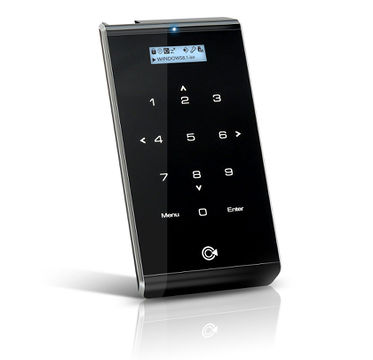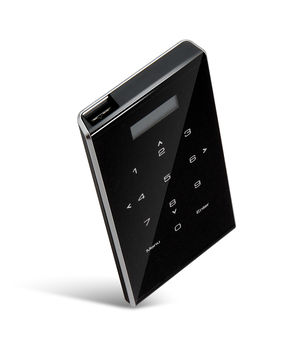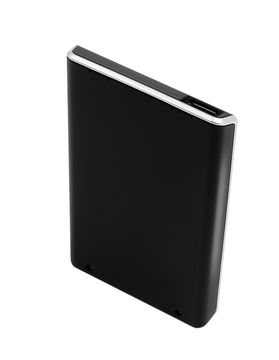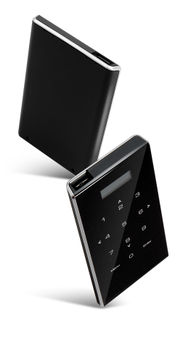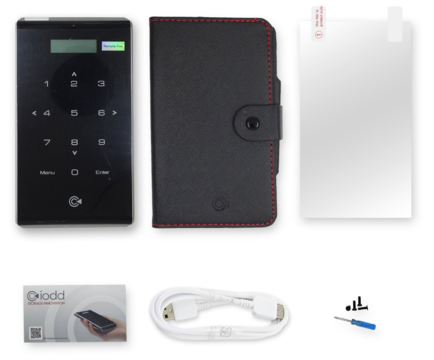IODD-2541
Contents
- 1 Appearance
- 2 Functions
- 3 Specifications
- 4 How to use
- 5 Manual
- 6 Troubleshooting
- 7 Firmware
Appearance
Functions
- Bootable Virtual CD-ROM, DVD-ROM, Blu-ray Drive
- There is no need to buy DVD-ROM and blank media for OS installation.
- ISO (CD, DVD, Blu-ray) is supported.
- Bootable Virtual USB Drive and Flash Drive.
- iODD supports OS installation and Multi Booting. (and "Windows-To-Go")
- Virtual Disk Drive - can do all functions as USB Flash Drive can do
- VHD and VMDK (Virtual Disk Drive), RMD (Virtual Flash Drive), IMA (Virtual Floppy Disk Drive) are supported.
- Multi LUN
- max 1 optical drive, 1 hard drive, 4 virtual drives are supported at the same time.
- hotkey for safely removal.
- The last physical safeguard. this key provides the safe removal.
- Write Protection
- The last logical safeguard. I keep my drive. Good bye Virus.
- Optional Write Blocker. (Hard wired)
- Real-time AES 256-bit XTS Military Grade Encryption ( iODD-2541 )
- 4-15 Pin digits. 6 digits is enough for protecting your data. (against the developer of iODD-2541)
- All functions work well with Encryption
- Encryption is optional. you can use without encryption.
- Maintain Loading State
- Save and maintain the loading state and menu for next boot.
Menu
- Mode Select - Define USB devices mode
- Dual Mode - 1 Hard Disk Drive and 1 Optical Disk Drive
- HDD Mode - 1 Hard Disk Drive.
- ODD Mode - 1 Optical Disk Drive.
- USB Control
- Write Protect - Write Protect the internal Disk Drive (Not Virtual Drive)
- Refresh - Reconnect the iODD
- Safe Removal - Stop the spindle motor and power down the Disk Drive
- Umount VHDD - Umount All the Virtual Disk Drives
- Information
- S.M.A.R.T. - Display the following status of the internal Disk Drive
- HDD Health - Disk Drive Health
- HDD Temp - Disk Drive Temperature
- HDD Model - Disk Drive Model
- HDD Serial - Disk Drive Serial
- Product Info
- Firmware Ver - iODD's Firmeare Version
- USB Speed - Currently connected USB Speed
- USB Lowest Volt - USB BUS lowest voltage
- Current Voltage - USB BUS current voltage
- S.M.A.R.T. - Display the following status of the internal Disk Drive
- Setting
- LCD Bright - Adjust LCD back-light bright
- Idle Bright - Adjust LCD back-light bright in power down mode
- Standby time - Adjust the inactive time before power down mode is active
- Load Default - Restoring all settings to their default values
- Encryption
- Warning - The Following action will destroy HDD data permanently
- But, Remove Encryption right after Set Encryption does not destroy HDD data
- Set Encryption - Input 4 - 15 digit PIN
- Remove Encryption
Specifications
- External Interface - USB 1.1 / 2.0 / 3.0 (MAX 5G bps)
- Internal Interface - SATA 1.0 / 2.0 / 3.0 (Backward Compatible)
- 2.5" HDD, SSD (9.5mm width) can be installed.
- 3-way jog switch, Back Button, USB 3.0 micro B-Type connector.
- LCD - 128 * 32 dots.
- Material - Aluminum, PC (Plastic).
How to use
- At first please refer to the below Manual.
Basic function
iODD's Sample Folder Tree
- create a folder named "_ISO" at root folder.
- This folder tree is an example.
- Any file name and folder name under "_ISO" is acceptable
J:├─_ISO│ │ Hiren’s BootCD 15.2.iso │ │ ubuntu-14.04.4-desktop-amd64.iso │ │ Windows 10.iso │ │ Windows XP sp3.iso │ │ (max 32 files or subfolders in a folder) │ │ │ ├─IMA for Floppy│ │ Bios updater.ima │ │ MS-DOS 6.0.ima │ │ Symantec Ghost.ima │ │ │ ├─RMD for Setup│ │ Win 7Ent_x86_x64+8.1Pro+10Pro vol2.RMD │ │ Win7_Ult_SP1_Russian_x64.RMD │ │ Windows 10.RMD │ │ │ └─VHD for Booting│ │ linuxmint-17.3-cinnamon-32bit.vhd │ │ Windows 10 Win2Go.vhd │ │ Windows 7 OS Booting.vhd │ │ │ └─Nested Subfolders is allowed├─Your Folder 01├─Your Folder 02├─Your Folder 99│ Your files 01.txt │ Your files 02.txt │ Your files 99.txt
2531 Keys
- Browsing
-
Jog DialUp/Down. - list Up/Down. -
Jog Dialpush. - Select a file. -
BackUppush. - Go to parent folder.
-
- Menu
-
Jog Dialpush for 3 seconds. - To enter to Menu mode. -
BackUppush. - To exit.
-
- Long key ( push for 3 seconds )
-
Jog Diallift up. - refresh the file lists -
Jog Dialget down. - Go to Power Saving State -
Jog Dialpush. - enter to Menu mode -
BackUppush. - Reboot. and detach all virtual drives (VHD, RMD, IMA)
-
- Startup Keys (during startup)
-
Jog-Diallift up. - Start up with CD-MODE -
Jog-Dialget down. - Start up with HDD-MODE -
Jog Dialpush. - reset the loading state. Start up with DUAL-MODE -
BackUppush. - Start up with Write-Protected mode.
-
2541 Keys
- Browsing
- Up/Down list -
2/8 - Select a file -
5(or6, for maintaining loading state)
- Up/Down list -
- Menu
-
Menu- to enter to Menu. (or Exit). -
4- Go to upper list
-
- Long key ( push for 3 seconds )
-
1- Go to Power Saving State -
3- reboots iODD -
4- refreshes file lists -
7- Reboot. and detach all virtual drives (VHD, RMD, IMA) -
0- Reboot. and temporarily disable Write-Protection
-
- There is not Startup key
Go to Power Saving State
- Power Saving State : Spindle motor is stopped and LCD brightness is low.
- CD loading state is saved.
-
Jog Dial. down for 3 seconds. (2531). -
1. push for 3 seconds. (2541).
Selecting a file
- In order to maintain loading state, you must save the state.
- refer to the above key operations.
- (2531) #2531 Keys
- If Firmware version is 1558 or higher, loading state is automatically saved.
- If not, you must save it manually. (Go to Power Saving State)
- (2541) #2541 Keys
- If Firmware version is lower than 6(7)9-05, button
6has no function.
- If Firmware version is lower than 6(7)9-05, button
Safely Removal In OS
- If iODD's partition is NTFS, then this function is mandatory when disconnecting iODD from host.
- NTFS does not write Immediately the data to HDD.
- Please do Safely Removal before disconnection.
- If iODD is in write-protected mode and an error message appears, then disable write-protect option. and retry this function.
Initialization
- the firmware is two sorts. (NTFS type, FAT32/exFAT type)
- NTFS firmware version is shipped.
- If you use FAT32 or exFAT Partition, then run FAT Firmware Updater. (FAT32 exFAT Partition)
- follow the next steps
- assemble the HDD or SSD with iODD
- connect the iODD to PC
- initialize the drive to MBR. (wken:MBR)
- Format the first partition as NTFS. (if the firmware is FAT, then format it as FAT32 or exFAT)
- In FAT32 partition there is 4G byte file size limitation. please use that carefully.
- create "_ISO" folder in root folder. (not case sensitive)
- copy ISO file to "_ISO" folder. (or create VHD RMD IMA files)
- safely remove iODD. ( very Important if NTFS). (safely remove).
- If Power Saving mode is active, then disconnect and reconnect the USB cable.
- If not, then Go to Power Saving State
- If "Plug Out ..." (or "Plug Out ...") message appears, reconnect the USB cable.
- The following messages will appear sequentially in LCD
- "iodd 253(4)1"
- a file name
Initialize All
- If Initialization fails, follow the next steps
- disconnect the USB cable.
- remove the HDD from iODD. and Connect directly it to PC.
- Initialize it to GPT. (msen:GPT)
- redo Initialization (from the first step). (your HDD is initialized as MBR -> GPT -> MBR).
- Open back cover
- Press tact switch
- Connect USB cable
- Wait 7 seconds
- Release tact switch
- Wait 1 minutes
- All done
First Aid
- If it has failure suddenly, try one of the following steps until the error is clear
- (2531). press the Jog Dial and hold. and then connect iODD to PC. (#2531 Keys. refer to Startup Keys)
- try Safely Removal In OS.
- Check Disk for iODD ( for Windows)
- Rename "_ISO" folder name to other name. create new folder named "_ISO". and copy files to this folder. (not moving)
- Update it with the latest firmware.
- Backup the data of iODD, and Initialize All
- If there is hardware problem
- Reboot the PC
- Please change USB cable
- Connect iODD to the port of PC back panel.
- Try it on another pc
- Please change the HDD.
Using a Virtual USB Optical Drive (DVD-ROM or Blu-ray ROM)
- copy ISO files to "_ISO" folder. (or to subfolder)
- Safely Remove. (Required for NTFS )
- If Power Saving mode is not active , then Go to Power Saving State
- If "Plug Out ..." (or "Plug Out ...") message appears, disconnect the iODD.
- Connect iODD to a PC. and power on the PC.
- (Optional) select iODD or USB CD-ROM as the first priority of BOOT order in BIOS.
- If a file has not been selected, then select an ISO file. Selecting a file
- If PC doesn't find boot device, then reboot the PC. (Ctrl-Alt-Del)
Booting Error
- Confirm whether the ISO file is bootable.
- If your PC does not support multi LUN, please select CD-MODE (or ODD-MODE).
- In order to confirm whether the ISO file is able to boot, please try to test it with the validated PC.
- Although it is bootable ISO file, please confirm whether the result with a real USB DVD-ROM is the same
- If the ISO file can be boot with USB DVD-ROM, then use USB Y-CABLE for adding external power.
- If your laptop has own internal DVD-ROM, please disable internal DVD-ROM at BIOS settings. or remove it.
- The older OS than motherboard may not have an appropriate driver to boot.
- ex) It is impossible to install a genuine Windows 7 on Skylake platform using USB DVD-ROM device.
Using a Virtual USB fixed disk drive (Virtual Hard Disk)
- Fixed-size VHD file only is supported. (dynamic VHD and VHDx files are not supported)
- Also fixed VMDK file is supported.
- Create VHD files directly to iODD by "VHD Tool++". ("VHD Tool++" can creates a file without fragment)
- You can create VMDK by changing file extension. (VHD -> VMDK).
- If you select a VHD file, then iODD will be rebooted with CD-MODE. and it will be recognized as a USB disk drive.(Selecting a file).
- If you want to change to DUAL-MODE or to change Write Protection option, rename the VHD filename. refer to "VHD Tool++"
- Max 4 Virtual Drives are supported at the same time ( Successive selection within 3 seconds)
- create a VHD file using a tool. (VHD Tool++).
- If successful, safely remove iODD from OS. (#Safely Removal In OS. Very Important to NTFS.)
- If Power Saving mode is not active, then Go to Power Saving State
- If "Plug Out ..." (or "Plug Out ...") message appear, disconnect the iODD.
- Connect iODD to a PC. and power on the PC.
- (Optional) select iODD or USB Device as the first priority of BOOT order in BIOS.
- If a file has not been selected, then select a VHD file. (Selecting a file)
- If PC doesn't find boot device, then reboot the PC. (Ctrl-Alt-Del)
Using a Virtual USB Removable Flash Drive (Virtual USB Flash Drive)
- Almost the same as the above method. (Using a Virtual USB fixed disk drive)
- But the file extension must be changed. "VHD" -> "RMD"
Using a Virtual USB Floppy Drive (Virtual FDD)
- This method is not supported on some computers.
- Uncompressed floppy image IMA, IMG, BIF, VFD are supported.
- IMG, BIF, VFD image file extension must be renamed to IMA.
- Almost the same as the above method.
Manual
Troubleshooting
Error Messages
"Check HDD" - Check HDD
- Do First Aid
"1st partition" or "unsupported partition" - Partition Mismatch with Firmware
- This error occurs if the firmware type does not match the first partition of iODD.
- Please Check the above Initialization.
"bad or N/S HDD" - bad or not supported partition
- This error occurs when iODD can not read the internal HDD.
- Please change the HDD or USB cable.
"Too Many Files" - too many files in a folder
- iODD allows max 32 files or sub folders in a folder. (under "_ISO" folder)
- Split a folder into subfolders.
"NO _ISO Folder" - there is no folder named "_ISO".
- create a folder named "_ISO" at root folder.
"NO - DISC" - there is no files in "_ISO" folder
- there is not a file or sub folder in _ISO folder.
"Disc Locked" - Disc is locked
- The OS or a application has locked the ODD drive at any reasons.
"DEFRAG" - defrag
- ISO file can have max 24 fragment in physical sector address. VHD and RMD must have no fragment.
- To solve this situation, please do Disk Defragmenter for Disk Defragmentation.
"vDISK Limit" - the number of virtual drives is more than limit
- The max number of Virtual disk drives is 4.
- You can not select more than 4 Virtual drives.
"Already Hit" - already selected
- You can not select the file that have been selected already.
"No Use Dynamic" - not supported dynamic VHD
- The VHD file selected is Dynamic VHD file. fixed VHD is only supported.
"No Use Sparse" - not supported sparse file
- The sparse image file is not supported as Virtual Drive.
QNA
iODD will not boot
Refer to Booting Error
The touch sensitivity is poor
please put thin paper or vinyl between the HDD and this product(not cover)
I have forgot my password. can i reset the password? i don't care my data will be lost
Refer to Initialize All
I have forgot my password. can i find out my PIN or restore my data?
No, It is absolutely impossible in spite of developer
The LCD shows only IODD 2541.
- Update the latest firmware.
If mount Virtual Drive (VHD, RMD, IMA) then the main mode will be changed automatically to CD-MODE, and If i change to DUAL-MODE then the disk is write protected.
- You can change this by changing file name. refer to VHD Tool++
I want to release the Virtual drives (VHD, RMD, IMA) that mounted.
- Try one of the following steps
- Press ans hold button '7' for 3 seconds ( Firmware 69+ or 79+)
- Menu->Advanced->Umount VHDD
The Firmware update has repeatedly failed
Please refer to How to update
Firmware
- There are 2 sorts of iODD's Firmware.
- FAT version - supports Fat32 and exFAT partition.
- NTFS version - supports NTFS partition. and 2 sorts of NTFS version. one is 6x , the other is 7x.
- 7x is more secure than 6x against brute force hacking.
- 6x and 7x are not compatible.
- you must backup your data before update encrypted iODD with other firmware.
How to update
- Requirements : PC ( Windows OS, USB Port)
- Warning - You must connect only one iODD device.
- Please update the exact firmware matching the first partition of iODD.
- If you update wrong firmware, retry the updater with correct firmware.
- Download the below firmware file.
- Uncompress the zip file to proper folder.(Do not run it within zip file)
- Run the EXE file.
- If "Device is Detected" message appears, then press "Update" button.
- If not, follow the next steps
- Use another PC.
- Change the USB cable.
- (for 2541.) Press the Reset button and hold, and connect the iODD. and hold the button for 1 second. and run the firmware updater.(this reset button is on the main PCB inside iODD.)
- (for 2531.) Press the Reset button and hold, and connect the iODD. and hold the button until USB detection (for about 5 seconds). and run the firmware updater.(this reset button is on the main PCB inside iODD.)
- If it is successful, then press "Exit" button. and reconnect iODD.
Latest
- 2016. 3. 28 - 69(79)-05 - NTFS version 6x, NTFS version 7x, FAT32/exFAT version 6x, FAT32/exFAT version 7x
- Fix minor bug.
Old
- 2016. 3. 26 - 69(79)-04 - NTFS version 6x, NTFS version 7x, FAT32/exFAT version 6x, FAT32/exFAT version 7x
- VHD, RMD are now supported with Rufus.
- Button '6' => Select VHD(or RMD, IMA) and the state is saved instantly.
- 2016. 3. 7 - 69(79)-03 - NTFS version 6x, NTFS version 7x, FAT32/exFAT version 6x, FAT32/exFAT version 7x
- Booting ability is same as iodd-2531.
